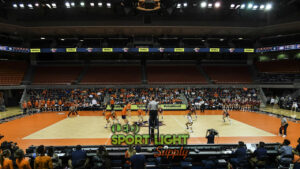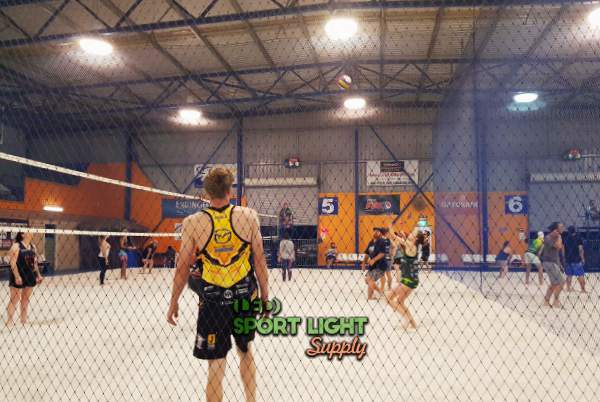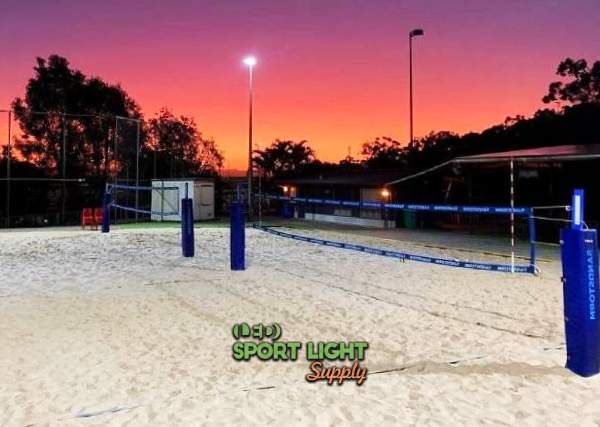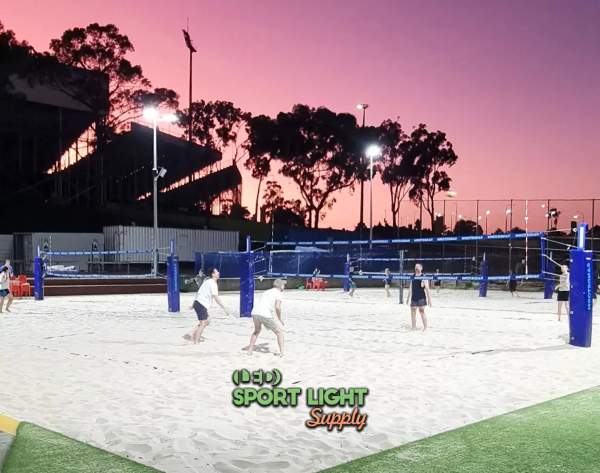
Table of Contents
Toggle| Volleyball Court Type | Recommended Lux Level | Description |
|---|---|---|
| Indoor Volleyball Court | 500 lux | Suitable for competitive play, providing clear visibility of the ball, players, and court lines. |
| Outdoor Volleyball Court | 300 lux | Adequate for recreational play, offering sufficient illumination for casual gameplay. |
| Outdoor Volleyball (Competitive) | 500-700 lux | Higher lux levels recommended for competitive outdoor matches to ensure visibility under varying outdoor conditions. |
| Training and Practice Areas | 200-300 lux | Lower lux levels for non-competitive practice sessions; suitable for basic training needs. |
| Professional Tournament (Indoor/Outdoor) | 750-1000 lux | High-end lighting levels to support televised events, ensuring excellent visibility for players, officials, and viewers. |
Volleyball courts demand specialized lighting solutions to create a safe and enjoyable playing experience. Whether indoors or outdoors, the lighting must provide consistent visibility across the entire court, helping players track the ball and make precise movements. To achieve this, volleyball court lighting should meet certain established standards, as well as adhere to best practices in fixture placement and glare management. When implemented effectively, these lighting standards enhance both performance and safety for players.
With the advancement of LED technology, sports lighting has made significant strides in efficiency and longevity. LED lighting has become the preferred choice for sports facilities worldwide, offering energy savings, durability, and quality illumination. Through this lighting technology, volleyball courts can maintain a high standard of play while benefiting from reduced operational costs.
 For indoor volleyball courts, achieving the correct lighting levels is essential to ensure that players can easily see the ball, their teammates, and court markings. According to industry standards, a minimum illuminance level of 500 lux is recommended for indoor volleyball. This level of brightness supports competitive gameplay, allowing players to react quickly and accurately to fast-moving plays. It also ensures that referees and spectators have clear visibility, contributing to a fair and engaging experience for everyone involved.
For indoor volleyball courts, achieving the correct lighting levels is essential to ensure that players can easily see the ball, their teammates, and court markings. According to industry standards, a minimum illuminance level of 500 lux is recommended for indoor volleyball. This level of brightness supports competitive gameplay, allowing players to react quickly and accurately to fast-moving plays. It also ensures that referees and spectators have clear visibility, contributing to a fair and engaging experience for everyone involved.
Indoor lighting must be carefully planned to avoid glare and shadows, which can interfere with a player’s ability to judge distance and speed. Fixtures are often mounted on the ceiling or in an overhead structure, with positioning and angles designed to minimize any potential disruption to visibility. Indoor lighting systems are generally more controlled environments compared to outdoor setups, allowing for precise adjustment of light levels and distribution.
 Outdoor volleyball courts have slightly different lighting requirements due to varying conditions such as location and weather. For recreational play, an illuminance level of 300 lux is generally considered adequate. However, higher brightness levels are often required for competitive outdoor matches to maintain the same level of visibility as indoor courts. Consistent illumination across the court is essential, as uneven lighting can lead to shadows that disrupt gameplay and affect player safety.
Outdoor volleyball courts have slightly different lighting requirements due to varying conditions such as location and weather. For recreational play, an illuminance level of 300 lux is generally considered adequate. However, higher brightness levels are often required for competitive outdoor matches to maintain the same level of visibility as indoor courts. Consistent illumination across the court is essential, as uneven lighting can lead to shadows that disrupt gameplay and affect player safety.
Outdoor lighting systems are typically mounted on poles around the perimeter of the court, with pole heights ranging from 8 to 12 meters depending on the court’s specifications. These elevated fixtures help distribute light evenly across the playing surface. Because outdoor courts are exposed to environmental factors such as rain, wind, and sunlight, the lighting design must also account for these elements to ensure continuous and reliable performance.
LED lighting has transformed sports facility lighting, offering numerous benefits that make it well-suited for volleyball courts. LEDs consume far less power than traditional lighting systems, resulting in significant energy savings. This reduced power consumption translates to lower electricity bills and a smaller carbon footprint, aligning with environmental and cost-saving goals for sports facilities.
One of the standout qualities of LED lighting is its exceptional lifespan. LEDs commonly last over 50,000 hours, significantly reducing the frequency of replacements. This longevity minimizes maintenance requirements, which is particularly advantageous in a sports setting where regular upkeep can disrupt gameplay. Additionally, LED lights provide uniform illumination without flickering, creating a stable visual environment that enhances player comfort and focus.
LED lighting is known for its durability, with resistance to shock and vibration that makes it suitable for sports environments. This durability is essential in volleyball courts, where fixtures may experience movement or impact from gameplay and environmental factors. Unlike traditional lighting options that may require frequent bulb replacements or repairs, LEDs maintain consistent performance over extended periods.
The long lifespan of LEDs means that facilities can save on maintenance costs over time. With fewer replacements needed, LED lighting systems reduce disruptions, allowing for uninterrupted use of the court. This durability also translates to reduced labor and replacement part costs, further supporting the long-term cost-effectiveness of LED lighting.
LED lighting systems are a sustainable choice for volleyball courts, both environmentally and financially. LEDs consume significantly less electricity than conventional lights, reducing energy costs and lowering greenhouse gas emissions. Many sports facilities seek to align with environmental sustainability goals, and using LEDs helps meet these objectives through reduced energy consumption and waste.
Another sustainability advantage of LEDs is that they do not contain hazardous materials like mercury, which is commonly found in older lighting technologies. This makes LEDs a safer option for users and reduces environmental impact when fixtures eventually reach the end of their life. The combination of energy savings and reduced environmental footprint makes LED lighting a responsible and forward-thinking choice for sports facilities.
 Uniform light distribution is fundamental to creating an optimal playing environment on volleyball courts. Unlike traditional light sources that scatter light in all directions, LED lighting is highly directional, enabling precise control over where light is distributed. This feature allows lighting designers to achieve even illumination across the court without creating hotspots or dark areas, which can affect gameplay.
Uniform light distribution is fundamental to creating an optimal playing environment on volleyball courts. Unlike traditional light sources that scatter light in all directions, LED lighting is highly directional, enabling precise control over where light is distributed. This feature allows lighting designers to achieve even illumination across the court without creating hotspots or dark areas, which can affect gameplay.
To ensure uniform distribution, LED fixtures can be strategically placed around the court based on the specific layout and dimensions. The placement should be carefully planned to prevent shadows, which can make it difficult for players to track the ball or judge distances accurately. Advanced LED systems offer adjustable beam angles and dimming capabilities, allowing for fine-tuning of light levels to match the needs of different types of play, from casual recreational games to professional matches.
The placement and angle of lighting fixtures play a key role in achieving effective visibility on volleyball courts. Fixtures must be positioned to minimize glare and avoid casting shadows on the playing surface. For indoor courts, lights are usually mounted on the ceiling or an overhead structure, while outdoor courts rely on pole-mounted fixtures for coverage.
For indoor volleyball courts, the standard practice is to mount fixtures at heights between 7 and 10 meters above the court. This height allows for balanced illumination across the playing area without creating shadow zones. For outdoor courts, pole heights typically range from 8 to 12 meters, allowing lights to cover a larger area while maintaining consistent brightness. Proper fixture height and angle are critical to achieving an unobstructed view of the court, which is essential for both players and spectators.
Glare can significantly impact a player’s ability to focus, while shadows may interfere with their perception of the ball and court boundaries. LED lighting systems designed for sports use often feature advanced optics that help manage glare. Through diffusers and reflectors, these optics soften the light, reducing the likelihood of harsh reflections that could distract players.
In addition to glare control, strategic fixture placement minimizes shadows cast on the court. By placing lights around the perimeter and focusing beams on specific areas, designers can ensure that shadows from players or equipment are reduced. This approach supports consistent visibility, helping players stay aware of their surroundings and maintain accurate judgment during fast-paced gameplay.
One of the most significant advantages of LEDs for volleyball court lighting is their ability to provide directional light. Traditional lights emit light in all directions, often requiring additional fixtures or reflectors to achieve focused illumination. LEDs, however, are inherently directional, allowing lighting designers to focus beams precisely where needed. This ability helps eliminate unwanted shadows, ensuring a uniform playing surface.
The adjustable beam angles available with LED systems offer added flexibility. By fine-tuning the angles, facilities can optimize light distribution to suit the specific needs of their court, whether it is for recreational use, practice sessions, or competitive matches. This versatility in directionality and beam control enhances the overall quality of lighting, providing a seamless experience for players and audiences alike.
LED lights are built to endure the rigors of sports environments, making them a practical choice for volleyball courts. Their resilience to shock and vibration ensures that they remain intact and operational even in high-impact settings. Traditional lighting, on the other hand, may suffer from shorter lifespans due to the demands of sports facility use.
The longevity of LED lighting also means fewer replacements over time. This reduced maintenance requirement minimizes disruptions to court usage, allowing facilities to operate smoothly without frequent interruptions for lighting repairs or replacements. The durability and reliability of LEDs ultimately lead to cost savings, reinforcing their value as a long-term investment for sports facilities.
The adoption of LED lighting for volleyball courts has redefined standards in sports facility lighting. With benefits such as energy efficiency, durability, uniform light distribution, and glare control, LEDs offer a comprehensive solution that meets the specific needs of volleyball gameplay. Proper planning of fixture placement and angle, combined with high-quality LED systems, allows for a well-lit court that supports both competitive and recreational play.
By reducing energy consumption and maintenance costs, LED lighting also aligns with the goals of sustainability and operational efficiency. Facilities that transition to LED lighting not only create a better environment for players but also contribute to environmental responsibility. LED lighting’s ability to provide clear, shadow-free illumination creates an atmosphere that enhances player performance, audience experience, and overall court safety.
LED technology continues to advance, offering sports facilities more options for enhancing visibility, efficiency, and sustainability. The combination of directional light control, reduced maintenance needs, and environmental benefits makes LED lighting an outstanding choice for volleyball courts. As facilities increasingly prioritize efficient and sustainable solutions, LED lighting stands out as a way to improve gameplay conditions while reducing costs and environmental impact.
In adopting LED lighting for volleyball courts, facilities invest in a system that supports high-quality, enjoyable sports experiences. With proper installation and planning, LED lighting provides volleyball courts with consistent, reliable illumination that benefits players, spectators, and the environment. The future of volleyball court lighting is bright with LED technology, delivering advantages that ensure the game is played at its best.
LED lighting has become a transformative solution for volleyball courts, merging high-quality illumination with sustainability and operational efficiency. Through energy savings, reduced maintenance needs, and enhanced player safety, LED systems provide a versatile and durable lighting option that meets the unique requirements of both indoor and outdoor volleyball environments. As technology advances, LED lighting continues to support a superior playing experience while aligning with environmental and economic goals. Investing in LED lighting equips volleyball facilities with the tools needed to deliver a well-lit, sustainable, and enjoyable environment for players and spectators alike, now and into the future.
Drop us a line to receive a free lighting design